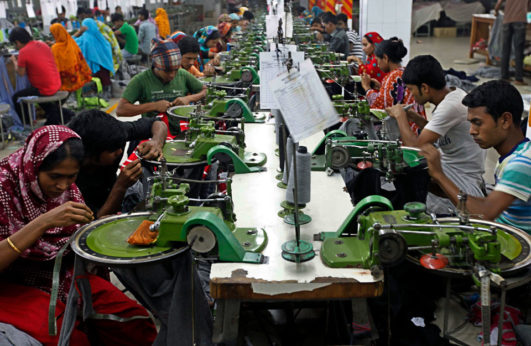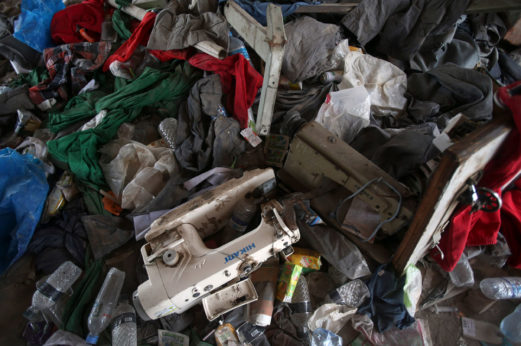
Is there a Marxist position on fashion? Maybe not a “position” as such—though some Marxists have also been notable fashionistas (and others, distinctly scruffy dressers). However, a Marxist approach can reveal quite a lot. Fashion is (arguably) unique to and a characteristic of our species.
Some other creatures adorn, advertise, or conceal themselves by “wearing” “foreign objects.” But in no case (as far as is known) is there any significant social transmission or evolution of habit. And clothing—its wearing and manufacture—is peculiar to humanity.
Human self-ornamentation goes back a long way. Anthropologists have speculated on its social purpose but, while materials or ornaments depend on what is locally available or can be procured from further afield, only in very few cases is there any clear evidence of environmental or functional determination of the precise detail of body adornment.
In other words, this seems to be just “fashion.” This seems likely to have been the case also for most of human history.
With the emergence of class societies, including slavery and feudalism, fashion took on a new role, as a marker of social status.

Different professions or craft guilds—from clergy to cobbler—distinguished and identified themselves through dress. Sometimes, as in royal courts from Ancien Regime France to Regency Britain, this could take an extreme form.
Dress became an essential element of the “rules of behavior”—emphasizing and maintaining social distinctions.
But within capitalism, fashion takes on a whole new character. Marx saw fashion as a dynamo as well as a product of capitalism.
Clothing was central to the industrial revolution; textile manufacture inaugurated the factory system in Britain with adults and children laboring in appalling conditions spinning cloth made from cotton produced by slaves on the other side of the Atlantic. The market for the product was driven not just by need, but by fashion.
Esther Leslie, a Marxist analyst of modern culture, describes how Marx saw fashion as a metaphor for capitalism.
In Capital, Marx wrote of “the murderous, meaningless caprices of fashion” linked to the general anarchy of capitalist production. Capitalism requires constant novelty—not just in the mode of production, but in products themselves—in order to maintain sales and profits.
Alongside “normal” business cycles and changes due to external factors such as the weather, “fashion, and the sudden placing of large orders that have to be executed in the shortest possible time” leads to precarious work; periods of “inhuman toil” alternating with starvation—a situation which intensified with the development of railways and telegraphs.
Marx quotes a manufacturer whose customers travel every fortnight from Glasgow, Manchester, and Edinburgh to the wholesale warehouses supplied by his factory “and give small orders requiring immediate execution, instead of buying from stock as they used to do.”
Not much has changed—except that the production process has been globalized and is dominated by finance capital.
Its excesses are manifest in episodes such as the collapse of Rana Plaza factory in Bangladesh in 2013, where in appalling conditions and on starvation wages, workers sweated producing fashion items for Benetton, The Children’s Place, Cato Fashions, Joe Fresh, and Walmart.
Some 1,134 garment workers were killed and 2,500 maimed.
Clothing accounts for 79 percent of total exports from Bangladesh; 43 percent of U.S. clothing workers are paid below the minimum wage and illegal low pay and long hours are rife in the British textile industry.
Fashion is not only exploitative of people; it is hugely destructive of the planet. Agrochemicals—pesticides and fertilizers—account for 77 percent of the cost of raw cotton production in Kenya.
Critics point to the way that expensive haute couture is inseparable from the wasteful and exploitative mass production and consumption of “cheap” fashion items, worn for a short time and then discarded.
And fashion has, in parallel with and intimately connected to its economic role as a vehicle for profit and exploitation, a cultural and ideological function.
Marx had a particular reason to be aware of the distinctions of dress. Having often had to pawn his own coat, he could not gain admittance to the British Library without redeeming it.
Its use-value was not just keeping Marx warm; it was also a signifier of respectability without which he would have been denied access.
Marx gave the name “rag-proletariat” (lumpenproletariat) to the poorest sections of the working class, immediately identifiable by their clothing.
“White-collar” workers don’t get their hands—or clothes—dirty. They signify their distance from manual workers in their dress.
Dress remains a signifier of social class distinctions and is sometimes inverted; the practice of going without a tie (or often, even a collar), unheard of a few decades ago, is normal among academics and increasingly tolerated among financial executives; it is often the lowest-paid workers (security, attendants) who are required to wear a uniform.
On the stock exchange trading floor, it is almost de rigeur for men to dress casually.
Ironically, dress is becoming a marker of prestige and power between institutions as well as within them. As Julie Burchill declared: “Satellites preen, superpowers dress down.”
Fashion is not just clothes. All fashion has its “derivatives”—shoes, bags, and accessories, which are great profit makers. Plus, of course, the multibillion-dollar hair and beauty product industry.
Tansy Hoskins, in her book Stitched Up: The Anti-Capitalist Book of Fashion, shows how capitalism “stitches up” its consumers as well as its workers and its raw materials—today not just in clothing but in pretty much every other commodity imaginable, from cars to the latest iPhone or other “must-have.”
The high-tech equivalent of Rana Plaza is the ongoing destruction of lives in factories such as Foxconn (in Shenzen, China, producing Apple electronics) and kids sorting through mountains of toxic junk at the other end of the value chain.
Fashion is central to capitalism’s underlying philosophy of “planned obsolescence”—the “systematic attempt of business to make us wasteful, debt-ridden, permanently discontented individuals.”
And it is central also to capitalism’s ability (so far) to ride out its crises by super-exploitation of both workers and consumers.
Fashion is the ultimate vehicle for alienation, reification, and commodity fetishism, persuading us to think that we “belong”—when we don’t—or to think that we’re “different”—when we’re not.
Elizabeth Wilson, in Adorned in Dreams, describes how a feminist backlash against fashion has itself been taken over by “deviant” fashion, exemplified by grunge.
Schedules for last month’s London Fashion Week Festival ended with top models parading in an Oxfam show to promote charity-shop chic.
One declared, apparently unaware of the irony: “It shows you can be whoever you want to be by shopping in Oxfam.”

“Fashion is a total system” and, says Leslie, far from being an aberration, it is at the core of capitalism and provides “a lens through which to explore it.”
Hoskins declares: “As an illustration of how capitalism operates, fashion is perfect. The inequality and exploitation are straight out of the past.
“Just as Queen Victoria wore dresses stitched by seamstresses who went blind in the candlelight, so today’s society it-girls now wear dresses stitched by Romanian sweatshop workers paid 99 pence an hour. […] Fashion allows exploitation to pretend to be something else, when in fact the beating heart of the fashion industry is not creativity but profit.
“To understand this, you need look no further than the writings of Marx and Engels, more than a century ago.”
Today, fashion attempts “to persuade us to buy things we don’t need with money we don’t have produced by people and processes we prefer not to think about, to create impressions that won’t last on people we don’t know.”
Under socialism, it is likely there will continue to be “fashions”—in dress and in much else.
Some of us may still remain “dedicated followers of fashion.” But fashion will no longer be dictated by the owners and managers of capital and subordinated to profit.
Morning Star









